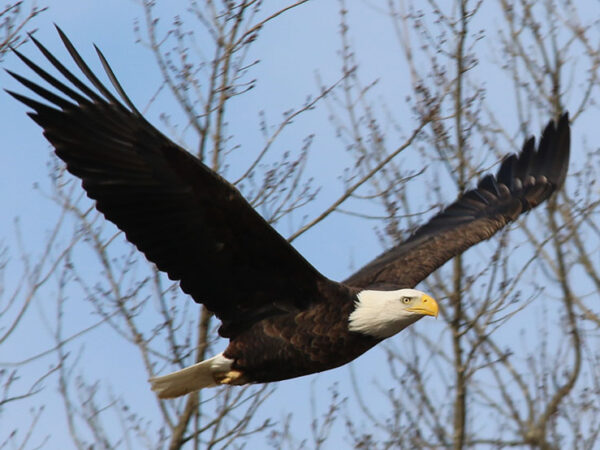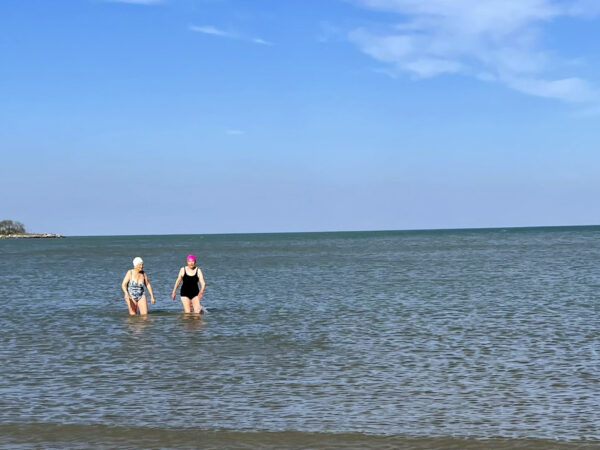
Great Lakes Moment is a monthly column written by Great Lakes Now Contributor John Hartig. Publishing the author’s views and assertions does not represent endorsement by Great Lakes Now or Detroit Public Television.
The Endangered Species Act was championed by metropolitan Detroit’s very own Congressman John D. Dingell and Senator Harrison Williams of New Jersey and signed into law by President Richard Nixon on December 28, 1973. It recognizes that both at-risk species and the ecosystems where they live need protection and that endangered and threatened species need worldwide protection through international treaties and conventions. The Center for Biological Diversity calls it one of the world’s most powerful legal tools for protecting species at risk of extinction.
According to the U.S. Department of Interior, which is responsible for endangered species conservation, the act has saved 99% of listed species from extinction. It credits this success to the collaborative actions of federal agencies, state, local, and Tribal governments, conservation organizations, and private citizens. On the 50th anniversary of the Endangered Species Act, it is good to reflect on some of its successes here in metropolitan Detroit’s backyard.
Bald Eagle
In the early 1900s, bald eagles were evenly distributed throughout Michigan. The population declined through the mid-1900s due to the loss of nesting habitat and human persecution – largely shooting, poisoning, trapping, and electrocution. During the 1950s, the birds’ decline accelerated and by the 1970s, they were on the brink of extinction. This period of decline was largely due to the increased use of organochlorine compounds such as DDT and PCBs following the Second World War. Birds exposed to these contaminants suffered reproductive failure, sterility, deformities such as crossed bills and eggshell thinning, altered foraging abilities, increased susceptibility to disease through immune system dysfunction, and in cases of acute poisoning, death.
In response to the ensuing public outcry, Michigan became the first state to ban DDT in 1969. It was banned nationally in 1972. In 1976, the U.S. Fish and Wildlife Service listed the bird as endangered in the lower 48 states.
Nesting pairs have since increased from 417 in 1963 to 71,400 in 2020. But for over 25 years, starting in the early 1960s, not a single bald eagle reproduced along the Detroit River and western Lake Erie shoreline. By the late 1980s, their reproductive success increased to the point where there were at least 25 active nests in 2012-2015.
In response to the birds’ recovery across the United States, the U.S. Fish and Wildlife Service removed the bald eagle from the endangered species list in 2007, although it’s still protected under the U.S. Migratory Bird Treaty Act and the Bald and Golden Eagle Protection Act. The U.S. Department of Interior notes that “the recovery of the bald eagle is a testament to the effectiveness of the Endangered Species Act in conserving and recovering imperiled species.”
Today, bald eagles can be spotted in metropolitan Detroit on Belle Isle, Humbug Marsh, off Dingell Park in Ecorse during winter, Lake Erie Metropark, Point Mouillee State Game Area, and Sterling State Park.
Osprey
Osprey were also heavily impacted by organochlorine compounds following the Second World War. Monitoring in Michigan showed the population declined precipitously during the 1950s through to the 1970s. By 2002, there was only one active nest in the southern part of the state. In response, osprey were listed as threatened in Michigan.
They were first reintroduced in metropolitan Detroit in the late 1990s. The population expanded substantially and the Michigan Department of Natural Resources’ goal of 30 nesting pairs in the southern half of the Lower Peninsula was achieved in 2010. In response, the Michigan Department of Natural Resources upgraded osprey from threatened to “species of greatest conservation need” in 2009. Throughout the United States, it is also still protected under the Migratory Bird Treaty Act of 1918.
Monitoring by a citizen conservation organization called Michigan Osprey has documented 38, 50, and 52 nesting pairs in metropolitan Detroit in 2015, 2016, and 2017, respectively. The Michigan Wildlife Council has noted that “few wildlife restoration programs have been more successful than Michigan’s effort to strengthen the state’s osprey population.”
Today, these birds can be spotted on Belle Isle, at Humbug Marsh, and in the wetlands behind Gibraltar’s Carlson High School.
Peregrine Falcon
Peregrine falcons were similarly decimated by organochlorine compounds during the 1950s. By the 1960s, the birds were experiencing complete reproductive failure in the Detroit River watershed and in the early 1970s, they were listed as endangered.
Peregrine falcons prefer perching and nesting on tall structures such as cliffs, bluffs, and skyscrapers where they can scan the horizon for prey. Following the banning of DDT and strict limitations on other organochlorine compounds, the Michigan Department of Natural Resources released five young in hacking boxes – wooden boxes designed to simulate nests – in downtown Detroit skyscrapers in 1987. After a slow start, reproduction picked up and now 30 peregrine young fledge each year throughout metropolitan Detroit.
In 1999, the peregrine falcon soared off the list of federally endangered species. BirdWatching notes the peregrine falcon’s recovery is one of the Endangered Species Act’s most dramatic success stories.
Today, they can be seen at the Fischer Building in Detroit, the Old Main Building at Wayne State University, the Detroit Zoo’s water tower, and the Ambassador Bridge to Canada.
Lake Sturgeon
Fishery biologists call lake sturgeon a “living dinosaur” because it thrived when dinosaurs roamed the earth. Before the 1860s, commercial fishermen slaughtered lake sturgeon as a nuisance fish because they became entangled in nets and because they sucked up spawn. During this era, lake sturgeon were also stacked like firewood and left to dry on the banks of the Detroit River. The mummified bodies of these oily fish were burned as fuel in steamboats plying the river. During the mid-1860s their economic value was recognized when their eggs became sought after as caviar and their smoked flesh craved as a delicacy. This led to the development of an important commercial fishery. During the late 1800s, the waters from Lake Huron to Lake Erie were one of the most productive for lake sturgeon in North America.
Predictably, they experienced a population crash, plummeting to one percent of their former abundance by the middle of the 20th century. The cause was overfishing, loss of spawning habitat, and water pollution.
From 1970s to 1999, there were no reports of spawning lake sturgeon in the Detroit River. In response, the Michigan Department of Natural Resources identified it as threatened in the 1990s. Ontario listed it as threatened in the 2000s.
Then in 2001, lake sturgeon spawned on a coal cinder pile near Zug Island in the Detroit River. Fishery biologists and managers concluded that in the 2000s lake sturgeon reproduction was more limited by habitat than by environmental quality. In response, ten spawning reefs for lake sturgeon and other rock-loving spawning fishes were constructed in the Detroit River. Today, U.S. Fish and Wildlife Service fishery biologists estimate the river’s sturgeon population at over 4,400.
Lake sturgeon can live more than 100 years and reach a length of seven feet. They are considered a good indicator of ecosystem health and are culturally significant to First Nations. Although not out of the woods, the current size of their population is a promising sign. The species’ recovery in the Detroit River is a result of the combined influence of the Clean Water Act, the Endangered Species Act, and strong linkages and efforts among fishery research scientists, fishery managers, and conservation organizations.
A good place to get up close and personal with a lake sturgeon is at the annual Sturgeon Day at Milliken State Park on the Detroit RiverWalk, sponsored by the Detroit Riverfront Conservancy and the U.S. Fish and Wildlife Service.
Reflections on the Golden Anniversary
According to the U.S. Department of Interior, the Endangered Species Act has saved hundreds of species from extinction and continues to protect and preserve some of our most beloved animals and plants. This act has also helped create a better understanding of how human activities can impact ecosystems of at-risk species. It has gifted us an awareness that what we do to our ecosystems we do to ourselves as well as to other species, and a greater appreciation for the need for all of us to work together to protect our ecosystems as our home.
John Hartig is a board member at the Detroit Riverfront Conservancy. He serves as a Visiting Scholar at the University of Windsor’s Great Lakes Institute for Environmental Research and has written numerous books and publications on the environment and the Great Lakes. Hartig also helped create the Detroit River International Wildlife Refuge, where he worked for 14 years as the refuge manager.
Catch more news at Great Lakes Now:
Great Lakes Moment: Detroit’s new Ralph Wilson Park will provide habitats for a healthy ecosystem
Great Lakes Moment: University of Windsor to build capacity for Canada’s national urban parks
Featured image: Photo courtesy of the National Oceanic and Atmospheric Administration.




